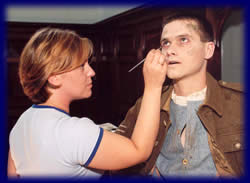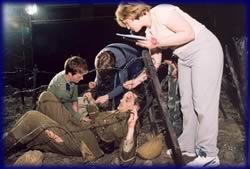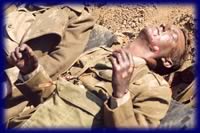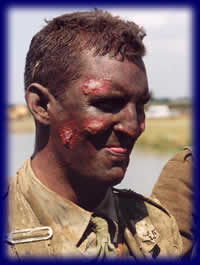|
|
Tracey Whalen designed the Make-up for 'Wilfred' |
|
|
|
The Make-up Challenge
Wilfred was the first period drama that I designed, so that in itself was a scary challenge. I had to research a lot more and in more detail than on other projects. I was never afraid to ask for advice, I think the fact that it was a majority northern crew filming in their region that everyone seemed to get together and want to make the project a success.
|
|
The role of a make-up artist is to make sure that the cast looks as authentic as we can possibly make them. To liaise with the rest of the crew especially the director for his visualisation of the scenes, costume dept to make sure which costumes/scenes we can cover with blood etc. and that we have the make-up and costume looking as if they are on the same person (not dirty faces with sparkly clean clothes), the cameraman to determine the best place to hide blood pumps etc. and to find out what exactly is in the shot.
|

|
|
|
The make-up challenges began with hairstyles, all the cast had to have the correct hairstyles and facial hair to be authentic to the period. (one of the extras came with what can only be described as a beach boy look, he would not let me cut his hair or shave his facial hair, so he could not be in the film, as he would not have been allowed to look like in that period of time.)
|
|
Research
I had to research all of the injuries likely to be sustained in WW1, different gunshot wounds, gassings, shrapnel wounds, charred limbs, fatigue, shock etc. The are two most memorable challenges which required research were having to create an entry and exit wound from a German rifle in very little time and creating a charred body, which I had not done before.
I must say, I thoroughly enjoy doing the research as I learn so much about authenticity. I used the hospital library for gunshot wounds, gas attacks, information on arteries and veins in certain areas of the body, and what colour blood certain injuries would it result in.
|

|
|
|
|
 
|
I went to the fire brigade local headquarters, they gave me information on fire, burn victims, explosion victims, they also gave me info on all sorts of different wounds that are inflicted on people (not a pretty sight). One important point that was used was the fact that when a body is burnt all the limbs constrict, resulting in bent arms, fingers, legs etc. also the tongue will protrude from the mouth, we used this info for the charred body scene.
I also went to the St Johns ambulance local headquarters to find out about wounds and treatments for them and recreations of them.
The Great War Society gave me info before and during shooting, which was invaluable.
|
|
Recreating Reality
I practised at home with different products and techniques until I found what I thought looked correct according to my research. Having researched what would happen to the body and tissue when a body was charred, and recreate it with the artist sitting in the boot of my car. This was a slow process as I layered the skin, colours and burn degrees, collodion and colouring techniques with the skin stretched when applied then constricted the skin and fingers, etc. which then splits the tissue and results in dry, torn skin as would happen in reality. I also added blistering to less affected areas using tissues, petroleum jelly and colouring.
|
|
|
|
Time restrictions with make-up offer another challenge, but I am pleased to say that I did do it under my stated time and everyone seemed pleased with the result.
The gunshot wounds were created by researching the firearms that Germanís used and what effect they had. Then I used prowax to create entry and exit wounds, coloured with wound filler, and different textures of pro-blood.
We constructed a blood pump using a gardening water pump and cables which were hidden from view, and pumped through the pre-prepared blood that that I had made.
|
|
Special Effects and the Future
Since completing the film it has reinforced my interest in Special Effects and I have completed a Nick Dudmen Special Effects course, I also prefer doing projects where there is more research to do, i.e. period drama, specific looks or wounds.
|
|
|
|
The completed film was a great accomplishment for everyone. I feel it was very well presented using the different media techniques so that it told a very emotional and horrific story without being disturbing, I still have people mentioning it to me.
I achieved a lot of goals during the filming and to see them in the completed film gave me a lot more confidence in my abilities and encouragement for my future work
|
|
|
|

